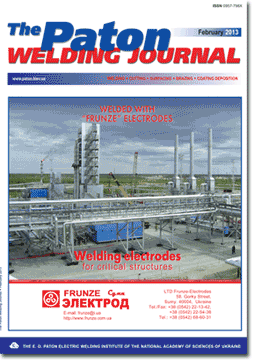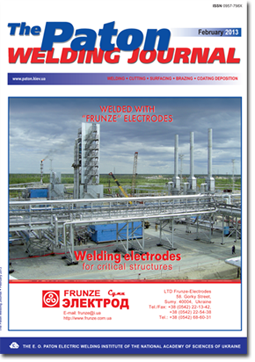| 2013 №02 (02) | 2013 №02 (04) |

The Paton Welding Journal, 2013, #2, 13-19 pages
MATHEMATICAL MODELLING OF STRESS-STRAIN STATE OF WELDED STRINGER PANELS FROM TITANIUM ALLOY VT20
O.V. MAKHNENKO, A.F. MUZHICHENKO and I.I. PRUDKY
E.O. Paton Electric Welding Institute, NASU, Kiev, Ukraine
Abstract
Improvement of methods for prediction of stress-strain state of welded joints in thin-sheet structures is a relevant problem. This, in particular, refers to stringer panels from VT20 titanium alloy which have high requirements on providing of high accuracy and strength at cyclic loads. Mathematical 3D modelling of stresses and deformations in small specimens (400 x 100-200 x 2.5 mm) with one stiffening rib and full size stringer panels (1100 x 550 x 2.5 mm) with four stiffening ribs was carried out under conditions of automatic non-consumable electrode welding by slot weld. Effect of preliminary elastic extension of plate and stiffening ribs on residual stress-strain state of panels was investigated. Computational investigations of stress-strain state for different variants of welding of the specimens showed that small width of panel specimens (100 mm) is not sufficient for determination of extension effect on residual stresses, and application of 200 mm width specimens is relevant for this purpose. The results of numerical calculations of stress-strain state for different variants of welding of stringer panels show principal possibility of performance at present time of such calculations in 3D problem statement for large welded structure with numerous welds, but at significant time consumption for calculation. 20 Ref., 3 Tables, 9 Figures.
Keywords: welded stringer panels, titanium alloy VT20, welding stresses and deformations, method of preliminary elastic extension, mathematical modelling
Received: 19.09.12
Published: 28.02.13
References
1. Kuzminov, S.A. (1974) Welding deformations of ship hull structures. Leningrad: Sudostroenie.
2. Vinokurov, V.A. (1968) Welding strains and stresses. Moscow: Mashinostroenie.
3. Talypov, G.B. (1974) Welding strains and stresses. Leningrad: Mashinostroenie.
4. Luo, Yy., Deng, D., Xie, L. et al. (2004) Prediction of deformation for large welded structures based on inherent strain. Transact. of JWRI, 33(1), 65-70.
5. Makhnenko, V.I. (1976) Computational methods of investigation of welded stress and strain kinetics. Kiev: Naukova Dumka.
6. Boitout, F., Dry, D., Gooroochurn, Y. et al. (2005) Distortion control for large maritime and automotive structures coupling with stamping simulation SYSWELD V2004. In: Proc. of SYSWELD Forum (Weimar, Sept. 2005), 107-120.
7. Camilleri, D., Gray, T. (2006) Optimization of welded lightweight multiple-stiffener plate structures to minimize unwanted shape distortion. Welding and Cutting, 6, 320-327.
8. Deng, D., Ma, N., Murakawa, H. (2011) Finite element analysis of welding distortion in a large thin-plate. Transact. of JWRI, 40(1), 89-100.
9. Ma, N.-X., Ueda, Y., Murakawa, H. et al. (1995) FEM analysis of 3-D welding residual stresses and angular distortion in T-type fillet welds. Ibid., 24(2), 115-122.
10. Gu, S.M., Murakawa, H., Ueda, Y. et al. (1996) Simulation of welding deformation for accurate ship assembly: Report 3. Ibid., 25(1), 69-79.
11. Deo, M.V., Michaleris, P. (2003) Mitigation of welding induced buckling distortion using transient thermal tensioning. Sci. and Technol. of Welding and Joining, 8(1), 49-54.
12. Lobanov, L.M., Makhnenko, O.V., Seyffarth, P. (1997) Computational prediction of welding deformations in production of flat sections for reduction of fit-up operations volume. Avtomatich. Svarka, 1, 21-24.
13. Paton, B.E., Lobanov, L.M., Tsybulkin, G.A. et al. (2003) Automated thermal straightening of welded thin-sheet structures. The Paton Welding J., 7, 2-6.
14. Makhnenko, O.V., Muzhichenko, A.F., Seyffarth, P. (2009) Application of mathematical modeling in thermal straightening of shipbuilding panels. Ibid., 1, 6-11.
15. (1967) Physical properties of steels and alloys used in power engineering: Refer. Book. Ed. by B.E. Nejmark. Moscow-Leningrad: Energiya.
16. (2005) GOST 22178-76: Sheets of titanium and titanium alloys. Technical requirements. Introd. 01.07.2005. Moscow: Standartinform.
17. (1997) GOST 19807-91: Titanium and titanium wrought alloys. Grades. Moscow: Standart.
18. Zinoviev, V.E. (1989) Thermophysical properties of metals at high temperatures: Refer. Book. Moscow: Metallurgiya.
19. Rykalin, N.N. (1951) Calculations of thermal processes in welding. Moscow: Mashgiz.
20. Makhnenko, V.I., Velikoivanenko, E.A., Pochinok, V.E. et al. (1999) Numerical methods for the prediction of welding stress and distortions. In: Weld. and Surf. Rev., Vol. 13, Pt 1. Amsterdam: Harwood Acad. Publ.
Suggested Citation
O.V. MAKHNENKO, A.F. MUZHICHENKO and I.I. PRUDKY (2013) MATHEMATICAL MODELLING OF STRESS-STRAIN STATE OF WELDED STRINGER PANELS FROM TITANIUM ALLOY VT20. The Paton Welding J., 02, 13-19.The cost of subscription/purchase order journals or individual articles
| Journal/Currency | Annual Set | 1 issue printed |
1 issue |
one article |
| TPWJ/USD | 384 $ | 32 $ | 26 $ | 13 $ |
| TPWJ/EUR | 348 € | 29 € | 24 € | 12 € |
| TPWJ/UAH | 7200 UAH | 600 UAH | 600 UAH | 280 UAH |
| AS/UAH | 1800 UAH | 300 UAH | 300 UAH | 150 UAH |
| AS/USD | 192 $ | 32 $ | 26 $ | 13 $ |
| AS/EUR | 180 € | 30 € | 25 € | 12 € |
| SEM/UAH | 1200 UAH | 300 UAH | 300 UAH | 150 UAH |
| SEM/USD | 128 $ | 32 $ | 26 $ | 13 $ |
| SEM/EUR | 120 € | 30 € | 25 € | 12 € |
| TDNK/UAH | 1200 UAH | 300 UAH | 300 UAH | 150 UAH |
| TDNK/USD | 128 $ | 32 $ | 26 $ | 13 $ |
| TDNK/EUR | 120 € | 30 € | 25 € | 15 € |
AS = «Automatic Welding» - 6 issues per year;
TPWJ = «PATON WELDING JOURNAL» - 12 issues per year;
SEM = «Electrometallurgy Today» - 4 issues per year;
TDNK = «Technical Diagnostics and Non-Destructive Testing» - 4 issues per year.


